

Prognostics for Systems Health Management - Model and Hybrid Based Approaches. Where are we heading? Dr. Chetan S. Kulkarni Diagnostics and Prognostics Group NASA Ames Research Center IMC 2020 ETH Zurich 9 th September Credits: NASA dit: www.nasa.gov
Acknowledgement Research Team – Diagnostics and Prognostics Group – NASA Ames Research Center Collaborators Prof. Olga Fink, Manuel Chao – ETH Zurich Dr. Kai Goebel – PARC Prof. Felipe Viana, Renato Nascimento - University of Central Florida Credits: NASA dit: www.nasa.gov
!"#$%#&'()& ! "#$%&'()*+$(#'&'$(,-./0#*1.'(&0(.(+0*/&2.&0)'0/3*'(/&0.#*$4*&'10, -./0#*1.'(&0(.(+0 ! 5%&'1.667*/+80#96'()*1.'(&0(.(+0 ! 5%&'1.667*%6.(('()*4$2*/%.20*+$1%$(0(&/ ! :0+$(4')92'()*&80*/7/&01*&$*.;$'#*9/'()*&80*+$1%$(0(&*-04$20*'&*4.'6/ ! <2$6$()'()*+$1%$(0(&*6'40*-7*1$#'47'()*8$=*&80*+$1%$(0(&*'/*9/0# ! 5%&'1.667*%6.(*$2*20%6.(*.*1'//'$( ! >7/&01*$%02.&'$(/*+.(*-0*$%&'1'?0#*'(*.*;.2'0&7*$4*=.7/
Credit: www.nasa.gov Credit: www.nasa.gov
Credit: www.nasa.gov Credit: www.nasa.gov
Credit: www.nasa.gov Credit: www.nasa.gov
*+"",%'-.'/',-#0-'1,-2"' Q Results tend to be intuitive Q Models can be reused Q Easy and Fast to implement Q May identify relationships Q If incorporated early enough in the design process, can that were not previously considered drive sensor requirements Q Requires lots of data and a Computationally efficient to implement “balanced” approach” Q Results may be counter(or Q Model development requires a thorough understanding of even un-)intuitive Q Can be computationally the system Q High-fidelity models can be intensive, both for analysis computationally intensive computationally intensive computationally intensive and implementation and implementation and implementation ! Regression analysis ! Paris-Erdogan Crack ! Neural Networks (NN) Growth Model ! Bayesian updates ! Taylor tool wear model ! Relevance vector machines ! Corrosion model (RVM) ! Abrasion model
Model-based prognostics ! State vector includes dynamics of normal and Offline Accelerated degradation process Aging x k = Ax k − 1 + Bu k − 1 + w k − 1 Training Trajectories y k = Hx k + v k Degradation Test Trajectory Modeling { y ( t 0 ) , . . . , y ( t p ) } D ˆ x ( t p ) { ˆ x ( t p +1 ) , . . . , ˆ x ( t p + N ) } Kalman Health State State-space Parameter Filter Forecasting Representation Estimation RUL Dynamic α i , ˜ Failure { ˜ β i } System Threshold Computation α , ˜ { ˜ β } D 2 Realization D Prognostics RUL ( t p ) ! EOL defined at time in which performance variable cross failure threshold Health State RUL Online Estimation Estimation R ( t p ) = t EOL − t p
Model-based prognostics ! 20 Tracking of health state based on Measured 15 Filtered t p =116 measurements Predicted 10 ! Forecasting of health state until failure 5 110 120 130 140 150 160 170 180 190 20 threshold is crossed 15 ! Compute RUL as function of EOL t p =139 10 defined at time failure threshold is 5 110 120 130 140 150 160 170 180 190 crossed 20 15 t p =149 10 5 110 120 130 140 150 160 170 180 190 20 15 t p =161 10 5 110 120 130 140 150 160 170 180 190 Aging time (hr)
Algorithm and Model Development TRL TRL4 TRL3 TRL2 TRL1
!"#$%&'()'"*&%&+(,&-'*./%&+(0$/1%#1( 0"*"2'3'* !"#$%&'"()*+,*-./'- !"#$%&'"()*+,*-./'- 4&-'*13"&-%&+("&-()'"*&%&+(,&-'*./%&+(( 5$/1%#1((67*(8720.'9(:/13'21 0.1/2*/*2(0'-/(3.4(
!"#$%&'()'"*&%&+(,&-'*./%&+(0$/1%#1( 0"*"2'3'* !"#$%&'"()*+,*-./'- !"#$%&'"()*+,*-./'- 4&-'*13"&-%&+("&-()'"*&%&+(,&-'*./%&+(( 5$/1%#1((67*(8720.'9(:/13'21 0.1/2*/*2(0'-/(3.4(
+
!"(#"-3#"4 Overall architecture of the residual-based (Hanachi et al., 2017). hybrid diagnostics (Rausch et al., 2005).
5,,6-7,/"%(%$-8-!19&()&-:#;,<-*/<(="/'(#% IO'")..$)"4&0('4(-"'$2H$(&'$&PF"05$8"21*23(043$H");'R2"/$ Calibration Policy H-30*1$8&P3043MF)3'5$)*5$5''8$.')"*0*1$;25'.3#$ Yuan Tian, Manuel Arias Chao, Chetan Kulkarni, Kai Goebel, Olga Fink, “Real-Time Model Calibration with Deep Reinforcement Learning”, arXiv:2006.04001 Manuel Arias Chao, Chetan Kulkarni, Kai Goebel, Olga Fink, “Fusing Physics-based and Deep Learning Models for Prognostics”, arXiv:2003.00732
Physics + RNN Overall architecture of the physics-informed Physics-informed neural network framework for recurrent neural network main bearing fatigue and grease degradation Nascimento, R. G., & Viana, F. A. (2019). Fleet prognosis with physics-informed recurrent neural networks. In Structural health monitoring 2019: Enabling intelligent life-cycle health management for industry internet of things (iiot) - proceedings of the 12 th international workshop on structural health monitoring (Vol. 2, pp. 1740–1747). Y. A. Yucesan and F. A. C. Viana, "A physics-informed neural network for wind turbine main bearing fatigue," International Journal of Prognostics and Health Management, Vol. 11 (1), 2020. (ISSN: 2153-2648).
Next Steps : Looking Ahead Credit: www.nasa.gov
>,?'-.',6&-@-7##4(%$-21,/; ML/Data Driven • High Model Granularity • Onboard/DM • Computational cost • Real time Physics Based • System Complexity • Available Data
>,?'-.',6&-@-7##4(%$-21,/; ML/Data Driven Q +P3(';$%2;8.'S0(P Q T2R$>25'.$7")*-.)"0(P Q !)()$+8'4("-;$)O)0.)F0.0(P Q IHH.0*'UI*.0*' Physics Based Q %2;8-()(02*).$423(
*#%)<+;(%$-A,B/"4& ! Prognostics helps enable ; Systems safe and efficient ; Decision making ! Hybrid Approaches ; Physics based methods can be combined with machine learning to determine and evaluate models for complex physical systems. ! High Fidelity simulation ! Field and Tests ; These models enable in verification and validation for autonomy in shorter period of time than current state of the art. ! Computational tools are two slow. ; With availability of test and field data, machine learning able to blend the digital data fabric for model update ; Uncertainty Quantification ! Framework still in early stages and needs maturation ! Requirements for autonomous systems !"
Thank You chetan.s.kulkarni@nasa.gov https://ti.arc.nasa.gov/tech/dash/groups/pcoe/
Recommend
More recommend